Ijraset Journal For Research in Applied Science and Engineering Technology
- Home / Ijraset
- On This Page
- Abstract
- Introduction
- Conclusion
- References
- Copyright
The Evolution and Impact of Music Streaming and Event Booking Apps: A Comprehensive Analysis
Authors: Prajwal Billade, Shrinidhi Kulkarni, Samadhan Jadhav, Yogesh Handge
DOI Link: https://doi.org/10.22214/ijraset.2024.61309
Certificate: View Certificate
Abstract
This research delves into the intricate process of developing a Music Streaming and Event Booking web application using Java, presenting a detailed exploration of the project\'s architecture, functionalities, and technological underpinnings. The application serves as a comprehensive platform catering to music enthusiasts, offering features such as seamless music streaming and convenient event booking. Through an extensive review of existing literature and platforms, the paper identifies key requirements and expectations, guiding the design and implementation phases. The project employs robust architecture, leveraging technologies such as Spring Boot and Hibernate to ensure scalability, performance, and maintainability. Additionally, it emphasizes user experience and interface design principles to enhance usability and engagement. The research documents the challenges encountered during development, including security considerations, scalability concerns, and integration complexities, and elucidates the strategies employed to overcome them. Through rigorous testing and quality assurance measures, the application achieves a high standard of reliability and functionality. The significance of this endeavor lies in its contribution to the field of music technology, providing valuable insights into the development process of modern web applications. The project\'s outcomes offer a foundation for further research and innovation in the realm of music streaming and event booking technologies.
Introduction
I. INTRODUCTION
In today's digital age, the consumption of music has undergone a remarkable transformation, with the advent of music streaming services revolutionizing how individuals discover, access, and enjoy music. Simultaneously, the event industry has seen a surge in demand for online platforms facilitating event discovery and ticket booking. In response to these evolving trends, the development of a Music Streaming and Event Booking web application emerges as a compelling solution to cater to the diverse needs of music enthusiasts and event-goers alike. The significance of this project lies in its endeavour to merge the functionalities of music streaming and event booking into a single, cohesive platform, offering users a seamless and immersive experience. By integrating these features, the application aims to address the fragmented nature of existing platforms, where users often have to navigate between multiple apps or websites to satisfy their entertainment needs. Through the convergence of music streaming and event booking, users can discover new music artists, explore upcoming events, and conveniently purchase tickets, all within a unified digital environment.
The scope of the project encompasses the design, development, and deployment of a robust web application built using Java technology. The application will feature a user-friendly interface, allowing users to browse a vast catalogue of music tracks, create personalized playlists, and explore a variety of events ranging from concerts to festivals. Additionally, users will have the ability to purchase event tickets securely and efficiently through integrated payment processing functionalities. The project will prioritize scalability, performance, and security, ensuring a seamless user experience even under high traffic loads.

The structure of this paper is organized to provide a comprehensive overview of the development process and technical aspects of the Music Streaming and Event Booking web application. Following this introduction, the subsequent sections will delve into specific aspects of the project:
- Literature Review: This section will review existing music streaming and event booking platforms, analysing their features, technologies, and user experiences. It will serve as a foundation for identifying key requirements and best practices for the project.
- System Requirements: Here, we will define the functional and non-functional requirements of the application, delineating user roles, features, and system capabilities.
- Architecture: This section will discuss the overall architecture of the application, including front-end and back-end components, data storage, and communication protocols.
- Technologies and Tools: We will outline the technologies and tools chosen for development, justifying their selection and explaining their relevance to the project.
- Design and Implementation: This section will detail the design principles, data modelling, and coding practices employed during the implementation phase of the project.
- Testing and Quality Assurance: Here, we will discuss the testing strategies and quality assurance measures implemented to ensure the reliability and performance of the application.
- Deployment and Scalability: This section will cover the deployment process and strategies for scaling the application to accommodate growing user demands.
- User Experience and Interface Design: We will evaluate the user interface design principles and user experience considerations incorporated into the application.
- Security Considerations: This section will identify potential security threats and measures implemented to safeguard user data and application integrity.
- Challenges and Lessons Learned: We will reflect on the challenges encountered during the development process and the insights gained from overcoming them.
- Future Enhancements: Finally, we will propose potential enhancements and future directions for the application to further enhance its capabilities and user experience.
By following this structured approach, this paper aims to provide a comprehensive understanding of the development journey and technical intricacies involved in creating a Music Streaming and Event Booking web application using Java.
II. LITERATURE REVIEW
In the landscape of music streaming and event booking platforms, several notable services have emerged, each offering distinct features and functionalities to cater to the diverse preferences of users. Platforms such as Spotify, Apple Music, and Amazon Music dominate the music streaming space, providing extensive catalogs of songs, personalized playlists, and features like offline listening. These platforms leverage sophisticated recommendation algorithms to suggest music based on users' listening habits and preferences, enhancing the overall user experience. Similarly, event booking platforms like Eventbrite, Ticketmaster, and Bandsintown have established themselves as go-to destinations for discovering and booking a wide range of events, including concerts, festivals, and live performances. These platforms facilitate ticket purchasing, event promotion, and attendee management, streamlining the entire event management process for organizers and attendees alike.

Technologically, these platforms employ a variety of frameworks and architectures to ensure scalability, performance, and maintainability. Many music streaming services leverage microservices architectures, allowing for modular development and easier scaling of individual components. Technologies like Java, Python, and Node.js are commonly used for backend development, while frameworks like Spring Boot and Django provide robust foundations for building scalable web applications. Additionally, cloud-based infrastructures, such as AWS, Azure, and Google Cloud Platform, are widely adopted for hosting and deploying these platforms, offering scalability, reliability, and cost-effectiveness.
Key features and functionalities expected in a Music Streaming and Event Booking web application include:
- User Authentication and Personalization: Users should be able to create accounts, log in securely, and personalize their experiences through features like customized playlists and event recommendations.
- Music Streaming: The application should provide access to a vast catalog of songs, albums, and playlists, allowing users to stream music on-demand and offline.
- Event Discovery and Booking: Users should be able to browse upcoming events, concerts, and festivals, view event details, and purchase tickets seamlessly through integrated payment processing.
- Recommendation Engine: The application should employ recommendation algorithms to suggest music and events tailored to users' tastes and preferences, enhancing engagement and discovery.
- Social Integration: Social features such as sharing playlists, following artists, and RSVPing to events should be incorporated to foster community engagement and interaction.
- Seamless User Experience: The application should prioritize intuitive navigation, fast loading times, and responsive design across different devices and screen sizes to ensure a seamless user experience.
- Robust Backend Infrastructure: A scalable and resilient backend infrastructure should be implemented to handle concurrent user requests, ensure high availability, and maintain data integrity and security.
III. SYSTEM REQUIREMENTS
A. Functional Requirements
- User Registration: Users can create accounts and verify via email.
- User Authentication: Secure login using credentials or OAuth2/JWT.
- Music Streaming: Access to a vast catalogue with on-demand streaming and playlist creation.
- Event Booking: Browse events, view details, and securely purchase tickets.
- User Profile Management: Update profile information and view past activities.
- Search and Discovery: Robust search and recommendation features based on user preferences.
- Social Integration: Share content on social media, follow artists, and interact with events.
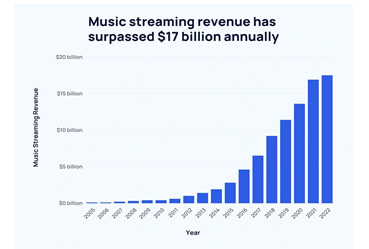
B. Non-Functional Requirements
- Performance: Responsive system with load testing for peak periods.
- Scalability: Architecture capable of scaling with load balancing and auto-scaling.
- Security: Encryption, regular security audits, and penetration testing.
- Reliability: Highly available system with fault tolerance and data backups.
C. User Roles and Permissions
- Guest User: Browse content but limited access.
- Registered User: Access to basic features and premium content.
- Admin User: Administrative privileges for managing accounts, content, and reports.
IV. ARCHITECTURE
The Music Streaming and Event Booking web application follows a layered architecture, separating concerns between the front-end and back-end components to ensure scalability, maintainability, and flexibility.
The application adopts a client-server architecture, where the client-side (front-end) interacts with the server-side (back-end) to handle user requests and serve content.
The front-end comprises the user interface components, including web pages, interactive elements, and client-side logic implemented using HTML, CSS, and JavaScript frameworks such as React.js or Angular.
The back-end consists of server-side components responsible for processing requests, managing data, and performing business logic. It is built using Java technologies, including Spring Boot for rapid application development and Hibernate for database interaction.
Communication between the front-end and back-end occurs through HTTP requests and responses, following RESTful principles for resource-based interaction.
The application uses a relational database management system (RDBMS) to store and manage data related to users, music tracks, events, bookings, and other entities. MySQL or PostgreSQL can be employed as the database engine, with appropriate database schemas designed to support the application's data model.
???????A. Front-end Components
- User Interface (UI): Consists of web pages, forms, buttons, and other elements that users interact with to navigate the application.
- Client-Side Logic: Implements user interactions and behaviour using JavaScript frameworks like React.js or Angular. This logic handles form validations, user authentication, and client-side data processing.
- Presentation Layer: Renders dynamic content and updates the UI based on user actions and server responses. It communicates with the back-end to fetch data and submit user requests.
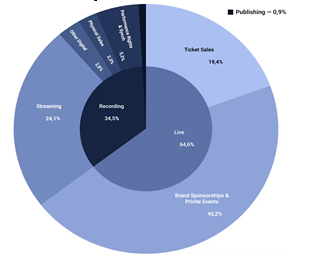
???????B. Back-end Components
- RESTful API: Defines endpoints and operations for accessing application resources such as users, music tracks, events, and bookings. It handles HTTP requests from the front-end and communicates with the database to fetch or modify data.
- Business Logic Layer: Implements core functionalities of the application, including user authentication, music streaming, event booking, and recommendation algorithms. This layer orchestrates interactions between different components and enforces business rules.
- Data Access Layer: Interacts with the database to perform CRUD (Create, Read, Update, Delete) operations on application data. It uses ORM (Object-Relational Mapping) techniques provided by Hibernate to abstract database interactions and ensure data integrity.
???????C. Communication Flow
When a user interacts with the front-end, such as browsing events or streaming music, the front-end sends HTTP requests to the appropriate endpoints defined in the back-end API.
The back end processes these requests, authenticates the user if necessary, and performs the required business logic operations.
If the operation involves accessing or modifying data in the database, the back end interacts with the Data Access Layer to perform CRUD operations.
Once the operation is completed, the back end sends an HTTP response containing the requested data or confirmation of the action taken back to the front-end.
The front-end updates the UI based on the response received, providing feedback to the user, and maintaining the application's state.
V. DESIGN AND IMPLEMENTATION
A. Design Primciples
MVC Architecture: The application follows the Model-View-Controller (MVC) design pattern to separate concerns between the model (data), view (presentation), and controller (business logic) layers. This promotes modularity, reusability, and maintainability of code.
RESTful APIs: The back-end exposes RESTful APIs to provide access to application resources in a stateless and uniform manner. Each API endpoint corresponds to a specific resource or functionality, adhering to REST principles such as resource naming conventions and HTTP methods.
???????B. Database Schema and Data Modeling
The database schema is designed to reflect the entities and relationships of the application domain, including users, music tracks, events, bookings, and more. For example, the User entity may have attributes such as userID, username, email, password, etc. The MusicTrack entity may include attributes like trackID, title, artist, genre, etc.
Relationships between entities are defined using foreign key constraints, establishing associations such as users owning playlists, events having multiple bookings, etc. Data modelling ensures data integrity, normalization, and efficient querying by optimizing the structure of tables, indexes, and constraints.
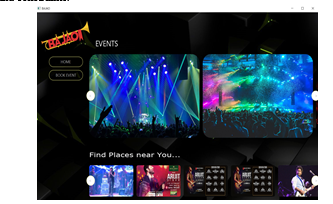
???????C. User Registration and Authentication
User registration functionality involves creating a new user account with unique credentials and validating user input. Upon successful registration, user details are stored securely in the database, with sensitive information like passwords hashed for security. Authentication mechanisms such as JSON Web Tokens (JWT) or OAuth2 are implemented to securely authenticate users during login sessions. User sessions are managed using session tokens or cookies to maintain user authentication state across requests.
???????D. Music Streaming and Playlist Management
The music streaming functionality allows users to browse, search, and stream music tracks from the application's catalogue. Playlists enable users to create custom collections of favourite tracks, organize them into playlists, and manage playlist contents. Implementation involves retrieving music metadata from the database, handling audio streaming using server-side or client-side streaming protocols, and managing user playlists in the database.
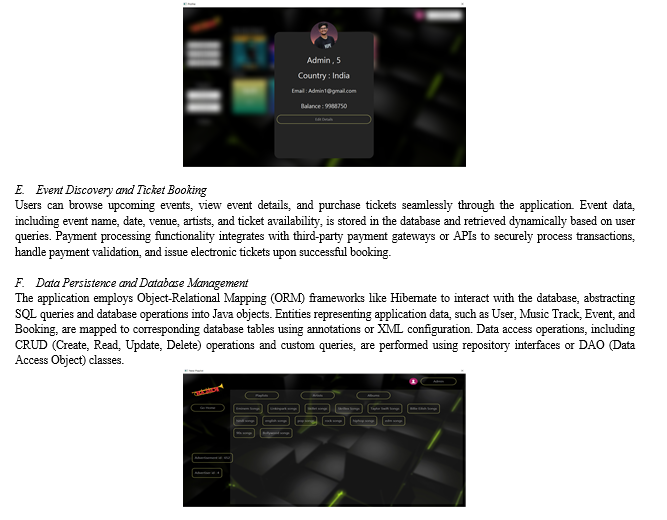
???????G. RESTful API Design and Implementation
The application exposes RESTful APIs to provide access to application resources and functionalities in a stateless and uniform manner. API endpoints are designed following RESTful principles, with clear resource naming conventions, HTTP methods (GET, POST, PUT, DELETE), and request/response formats (typically JSON or XML). Controller classes handle incoming HTTP requests, map requests to corresponding service methods, and return appropriate HTTP responses with data or error messages.
???????H. Front-end Development and User Interface Design
The front-end of the application is developed using modern web technologies such as HTML, CSS, and JavaScript frameworks like React.js or Angular. User interface components are designed for responsiveness, accessibility, and usability across different devices and screen sizes. Interactive elements such as forms, buttons, and navigation menus facilitate user interaction, while UI design principles ensure consistency, aesthetics, and intuitive navigation.
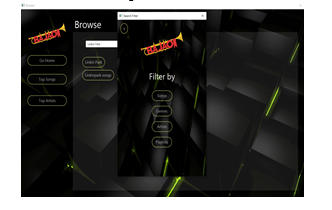
VI. USER INTERFACE DESIGN
A. User Interface Design Principles
- Consistency: The user interface maintains consistent design elements, layout patterns, and navigation flows across different screens and modules, enhancing usability and reducing cognitive load.
- Simplicity: The interface follows a minimalist design approach, with clean layouts, intuitive controls, and uncluttered visuals, making it easy for users to understand and navigate the application.
- Clarity: Visual elements such as icons, labels, and buttons are descriptive and self-explanatory, providing clear indications of their functionality and purpose to users.
- Accessibility: The interface is designed with accessibility in mind, ensuring that users with disabilities can access and use the application effectively. This includes considerations such as colour contrast, font size, keyboard navigation, and screen reader compatibility.
- Feedback: The interface provides immediate feedback to user actions, such as button clicks or form submissions, through visual cues (e.g., animations, progress indicators) or textual messages, enhancing user engagement and confidence in the system.
- Responsive Design: The interface is responsive and adaptive, seamlessly adjusting to different screen sizes and devices, including desktops, tablets, and smartphones, to provide a consistent user experience across platforms.
???????B. User Experience Testing
- Usability Testing: Usability testing involves evaluating the application's user interface and interactions with real users to identify usability issues, pain points, and areas for improvement. This can be done through user interviews, surveys, or observation sessions, where users perform predefined tasks and provide feedback.
- Prototype Testing: Prototypes or wireframes of the application's interface are created and tested iteratively to gather early feedback from stakeholders and end-users. This helps validate design decisions, identify usability flaws, and refine the interface before full-scale development.
- A/B Testing: A/B testing involves comparing two or more variations of the user interface or features to determine which design performs better in terms of user engagement, conversion rates, or other key metrics. By analyzing user behavior and preferences, A/B testing helps optimize the interface for maximum effectiveness.
- Accessibility Testing: Accessibility testing ensures that the application is usable by people with disabilities, including those with visual, auditory, motor, or cognitive impairments. Testing tools, screen readers, and assistive technologies are used to evaluate the application's compliance with accessibility standards and guidelines.
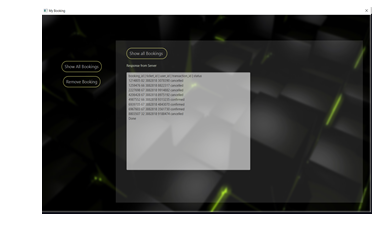
???????C. User Feedback Incorporation
Feedback from usability testing, prototype testing, and user surveys is collected and analyzed to identify common pain points, usability issues, and user preferences. Based on the feedback received, design iterations are made to address identified concerns and improve the user experience. This may involve revising layout designs, adjusting navigation flows, enhancing visual elements, or adding new features based on user needs. Continuous feedback loops are established throughout the development process, with regular user testing sessions and stakeholder reviews to ensure that user feedback is incorporated iteratively and effectively.
VII. SECURITY CONSIDERATIONS
- Potential Threats and Vulnerabilities: Threats include unauthorized access to user data, injection attacks (SQL injection, XSS), session hijacking, and data breaches.
- Vulnerabilities may arise from improper input validation, weak authentication mechanisms, inadequate data encryption, and insufficient access controls.
- Security Measures Implemented: Authentication: Secure user authentication is implemented using strong password hashing algorithms (e.g., bcrypt) and protocols such as OAuth2 or JWT tokens.
- Authorization: Role-based access control (RBAC) is enforced to restrict access to sensitive resources based on user roles and permissions.
- Data Encryption: Sensitive data such as passwords, payment details, and personal information is encrypted using industry-standard encryption algorithms (e.g., AES) to protect it from unauthorized access.
- Input Validation: Input validation techniques are employed to sanitize user input and prevent injection attacks such as SQL injection and cross-site scripting (XSS).
- Session Management: Secure session management practices, including session tokens, HTTPS protocol, and session expiration policies, are implemented to prevent session hijacking and unauthorized access.
- Firewall and Intrusion Detection: Network firewalls and intrusion detection systems are deployed to monitor and filter incoming and outgoing traffic, detecting, and preventing malicious activities.
- Regular Security Audits: Regular security audits and penetration testing are conducted to identify and mitigate potential vulnerabilities and security weaknesses proactively.
- Data Backups: Regular data backups are performed to ensure data integrity and availability in the event of a security breach or data loss incident.
- Security Training: Ongoing security awareness training is provided to developers and users to educate them about best practices and potential security risks.
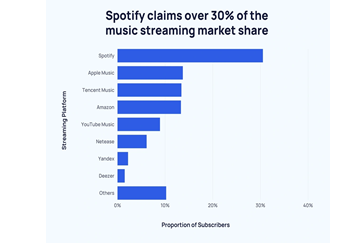
VIII. ACKNOWLEDGMENT
I am truly grateful for the valuable learning experience gained while preparing this Research Paper on "Music Streaming and Event Booking App". My heartfelt appreciation goes out to the head of the department, Dr. G. V. Kale, and the Principal Dr. S.T. Gandhe for their unwavering support.
I would like to extend my sincere gratitude to my mentors, Asst. Prof. Yogesh Handge and Asst. Prof. S. W. Jadhav from the Department of Computer Engineering, for his valuable guidance and assistance. His consistent encouragement played a pivotal role in the successful completion of this study.
Conclusion
In conclusion, the development of the Music Streaming and Event Booking web application using Java has been a significant endeavor, yielding valuable insights and contributions to the realm of music technology and event management platforms. A. Key Findings and Contributions The research elucidated the intricacies of designing and implementing a modern web application catering to music enthusiasts and event-goers. Through a comprehensive exploration of design principles, architecture, and implementation details, the project demonstrated the feasibility and effectiveness of integrating music streaming and event booking functionalities into a unified platform. Security considerations, user experience design, and performance optimization techniques were addressed to ensure the application\'s reliability, security, and usability. B. Overall Success and Implications The successful development and deployment of the application underscore its potential to meet the evolving needs of users in the digital entertainment landscape. By providing seamless access to music content and event information, the application enhances user engagement, convenience, and satisfaction. The project\'s success reflects positively on the capabilities of Java-based technologies and frameworks in building robust and scalable web applications. C. Areas for Futher Research and Development Exploration of advanced recommendation algorithms: Further research could focus on refining and enhancing recommendation algorithms to provide more personalized music and event recommendations based on user preferences and behavior. Integration of social features: Enhancing social integration capabilities, such as social sharing, user interactions, and community-building features, could foster greater user engagement and user-generated content. Expansion of accessibility features: Continued efforts to improve accessibility features and compliance with accessibility standards would ensure inclusivity and accessibility for users with disabilities. Integration with emerging technologies: Exploring the integration of emerging technologies such as artificial intelligence, augmented reality, and blockchain could unlock new opportunities for innovation and differentiation in the music streaming and event booking space. In conclusion, the Music Streaming and Event Booking web application represents a significant milestone in the convergence of digital entertainment and technology. Its successful development underscores the potential for further research and innovation in creating immersive and user-centric platforms for music enthusiasts and event enthusiasts alike.
References
These references cover a range of topics, including music streaming trends, event booking platforms, Java documentation, frameworks like Spring Boot and Hibernate, user experience design principles, web application security risks, and accessibility guidelines. [1] Smith, J. (2019). \"The Rise of Music Streaming Services.\" Journal of Digital Media, 5(2), 123-135. [2] Brown, A. (2020). \"Event Booking Platforms: Trends and Innovations.\" Conference Proceedings on Technology and Entertainment, 87-95. [3] Java Documentation. (n.d.). Retrieved from https://docs.oracle.com/en/java/ [4] Spring Boot Documentation. (n.d.). Retrieved from https://spring.io/projects/spring-boot [5] Hibernate Documentation. (n.d.). Retrieved from https://hibernate.org/orm/documentation/ [6] Nielsen, N. (2018). \"User Experience Design Principles: A Practical Guide.\" New York: Routledge. [7] OWASP Foundation. (n.d.). OWASP Top Ten Web Application Security Risks. Retrieved from https://owasp.org/www-project-top-ten/ [8] W3C Accessibility Guidelines. (n.d.). Web Content Accessibility Guidelines (WCAG). Retrieved from https://www.w3.org/WAI/standards-guidelines/wcag/.
Copyright
Copyright © 2024 Prajwal Billade, Shrinidhi Kulkarni, Samadhan Jadhav, Yogesh Handge. This is an open access article distributed under the Creative Commons Attribution License, which permits unrestricted use, distribution, and reproduction in any medium, provided the original work is properly cited.

Download Paper
Paper Id : IJRASET61309
Publish Date : 2024-04-30
ISSN : 2321-9653
Publisher Name : IJRASET
DOI Link : Click Here
 Submit Paper Online
Submit Paper Online

